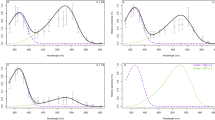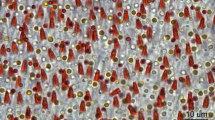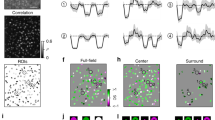Abstract
THE function of the brightly coloured oil droplets situated within the cone receptors of the avian retina has long been the subject of debate1–4. Among other hypotheses it has been suggested that they reduce glare and chromatic abberation1, remove unwanted short-wavelength sensitivity2, and have a role in colour vision3–5. The transmission spectra of the droplets in the visible spectrum are typically those of short wavelength cut-off filters5,6–8, due to the presence in high concentration of carotenoids of dietry origin9–11. Recent evidence from microspectrophotometry suggests that the droplets filter the light reaching the visual pigment in the receptor's outer segment, resulting in the modification of the sensitivity functions of some of the individual receptors, from the broad band sensitivity of the visual pigment alone to a narrow band one12,13. It is also known that marked differences occur in the proportions of the variously coloured droplets between species, and also between different parts of the retina of a given species4,14–16. In the pigeon (Columba livia) the retina is divided into two distinct areas, known as the red and yellow fields, defined by their oil droplet populations. The red field is in the dorsal retina (frontal–ventral visual field), whereas the yellow field is in the ventral retina (dorsal visual field): the two fields differ in both the type and number of broad and narrow band receptors present, as well as in receptor density and the neural complexity of the retina13,17,18. We report here clear differences in the photopic spectral sensitivity of the two fields, determined behaviourally, and suggest that these reflect a difference in the colour vision mechanisms of the two areas.
This is a preview of subscription content, access via your institution
Access options
Subscribe to this journal
Receive 51 print issues and online access
$199.00 per year
only $3.90 per issue
Buy this article
- Purchase on Springer Link
- Instant access to full article PDF
Prices may be subject to local taxes which are calculated during checkout
Similar content being viewed by others
References
Walls, G. L. & Judd, H. D. Br. J. Ophthal. 17, 641–675 (1933).
Wolbarsht, M. L. Fedn Proc. 35, 44–50 (1976).
Bloch, S. & Maturana, H. R. Nature 234, 284–285 (1971).
Muntz, W. R. A. in Handbook of Sensory Physiology VII/1 (ed. Dartnall, H. J. A.) 529–565 (Springer, Berlin, 1972).
King-Smith, P. E. Vision Res. 9, 1391–1399 (1969).
Fujimoto, K., Yanase, T. & Hanaoka, T. Jap. J. Physiol. 7, 339–346 (1957).
Strother, G. K. & Wolken, J. J. Expl cell. Res. 21, 504–512 (1960).
Leibman, P. E. in Handbook of Sensory Physiology VII/1 (ed. Dartnall, H. J. A.) 481–528 (Springer, Berlin, 1972).
Wald, G. & Zussman, H. Nature 140, 197 (1937).
Leibman, P. A. & Granda, A. M. Nature 253, 370–372 (1975).
Meyer, D. B. Ophthalm. Res. 2, 104–109 (1971).
Bowmaker, J. K. & Knowles, A. Vision Res. 17, 755–764 (1977).
Bowmaker, J. K. Vision Res. 17, 1129–1138 (1977).
Peiponen, V. A. Ann. Zool. Fenn. 1, 281–302 (1964).
Waelchli, G. Archs Ophthalm. 29, 205–233 (1883).
Galifret, Y. Zeit. Für Zellforschung. 86, 535–545 (1968).
Yazulla, S. J. comp. Neurol. 153, 309–324 (1974).
Clarke, P. G. H. & Whitteridge, D. Q. Jl exp. Physiol. 6, 351–358 (1976).
Martin, G. R. & Muntz, W. R. A. in Neural Mechanisms of Behaviour in the Pigeon (ed. Granda, A. M. & Maxwell, J. H.) (Plenum, New York, in the press).
Blough, D. S. J. opt. Soc. Am. 47, 827–833 (1957).
Romeskie, M. & Yager, D. Vision Res. 16, 501–505 (1976).
Abramov, I. in Handbook of Sensory Physiology VII/2 (ed. Fuortes, M. G. F.) 567–607 (Springer, Berlin, 1972).
Author information
Authors and Affiliations
Rights and permissions
About this article
Cite this article
MARTIN, G., MUNTZ, W. Spectral sensitivity of the red and yellow oil droplet fields of the pigeon (Columba livia). Nature 274, 620–621 (1978). https://doi.org/10.1038/274620a0
Received:
Accepted:
Issue Date:
DOI: https://doi.org/10.1038/274620a0
This article is cited by
-
Absorbance of retinal oil droplets of the budgerigar: sex, spatial and plumage morph-related variation
Journal of Comparative Physiology A (2012)
-
Tetrachromatic colour vision in the duck (Anas platyrhynchos L.):microspectrophotometry of visual pigments and oil droplets
Journal of Comparative Physiology A (1988)
-
The pigeon's sensitivity to ultraviolet and ‘visible’ light
Experientia (1983)
-
Stimulus display geometry and colour discrimination learning by pigeons
Current Psychology (1981)
Comments
By submitting a comment you agree to abide by our Terms and Community Guidelines. If you find something abusive or that does not comply with our terms or guidelines please flag it as inappropriate.



